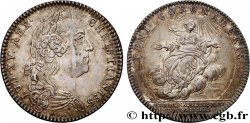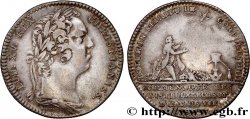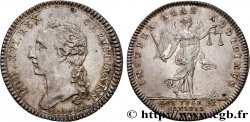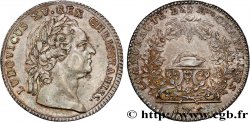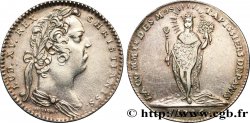fjt_048546 - CORPORATIONS 1723
Catalogue references :
Obverse
Obverse legend : DE. LA. PREVOTE. DE. MRE. P. A. DE. CASTAGNERE. MARQ. DE. CHATEAUNEUF. CER. DETAT.
Obverse description : Armes de P. de Castagnère : écartelé au 1 : d'azur, au globe d'or croisé de même et cintré de gueules, au 2 : d'azur au lion d'or, à la fasce brochante de gueules chargée de 3 roses d'argent, au 3 : de gueules à 3 chevrons d'or, au 4 : palé d'argent et d'azur, au chevron de gueules brochant sur le tout. Sur le tout : d'or, au châtaignier arraché de sinople.
Reverse
Reverse legend : A L'EXERGUE : LA VILLE DE PARIS / 1723.
Reverse description : Armes de Paris.
Commentary
Pierre-Antoine de Castagnère, marquis de Châteauneuf et de Marolles. Son élection donna lieu à quelques difficultés, attendu qu’il était né en Savoie, à Chambéry, et que les membres du Bureau de la Ville devaient être parisiens ; mais le roi, par lettre de cachet, ordonna de passer outre. A raison de son grand âge, M. de Châteauneuf ne fit que la première année de sa troisième prévôté. Reçu conseiller au Parlement le 10 mai 1675, il quitta la magistrature pour suivre la carrière diplomatique ; il fut ambassadeur à Constantinople en 1689, à Lisbonne en 1703, en Hollande en 1713 ; dans le courant du mois d’août 1719, il entra au Conseil d’État. Par lettres patentes de mars 1721, registrées au Parlement le 21 mars de l’année suivante, le roi donne à la Ville l’île des Cygnes pour y établir un atelier de déchirage des bateaux, ainsi qu’un port public pour les bois à brûler et à ouvrer.
La date donnée par Feuardent, 1721, n’est pas celle qui se lit sur le jeton.
La date donnée par Feuardent, 1721, n’est pas celle qui se lit sur le jeton.








 Report a mistake
Report a mistake Print the page
Print the page Share my selection
Share my selection Ask a question
Ask a question Consign / sell
Consign / sell
 Full data
Full data